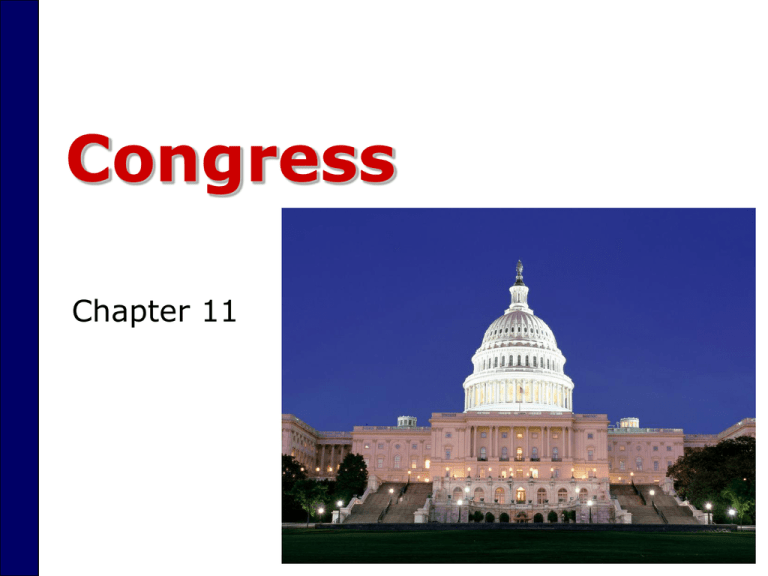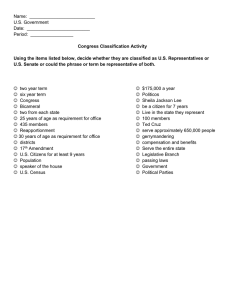Congress Chapter 11
advertisement

Congress Chapter 11 The Constitution and the Legislative Branch of the Government Article I describes structure of Congress Bicameral legislature Divided into two houses Each state sends two Senators regardless of population. Number of representatives each state sends to the House is determined by state population. The Constitution and the Legislative Branch of the Government Constitution sets out requirements for membership in the House and Senate House – 25 years of age; reside in U.S. at least 7 years; serve 2 year terms Senate – 30 years of age; reside in U.S. at least 9 years; serve 6 year terms ; originally chosen by state legislators, until 17th Amendment (1913) Congressional members must be legal residents of their states. The Representatives and Senators The Job Salary of $174,000 (2009) with retirement benefits. Who sets their salary? ($193,400 for leaders, $223,500 for the Speaker) Office space in D.C. and at home and staff to fill it. The Representatives and Senators The Job Travel allowances and franking (see below and next slide) privileges. Often requires 10 to 14 hour days, lots of time away from the family, and lots of pressure from different people to “do the right thing.” Congressional Demographics Members tend to be Better educated than the population in general Ninety-five percent are college graduates; over 2/3’s have advanced degrees. Richer Nearly 200 are millionaires; 21 Senators are worth at least 3.1 million. 29 House members worth that much as well. Who is the richest Senator? Male White Congressional Demographics Members tend to be Average age is 63 for Senators; 57 for House members. Aaron Schock (R-IL) elected in 2008 at age of 27. Occupations: No longer overwhelmingly lawyers 214 members (182 Representatives and 33 Senators) list their occupation as public service/politics 204 (152 Representatives and 51 Senators) list law 201 (175 Representatives and 27 Senators) list business Apportionment and Redistricting Apportionment Proportional process of allotting congressional seats to each state following the ten year census. Who is responsible for this? Redistricting Redrawing of congressional districts to reflect increases or decreases in seats allotted to the states, as well as population shifts within a state 1929: House size fixed at 435. Congressional Elections Who Wins Elections? Why? Incumbent: Those already holding office. Percentage of Incumbents Reelected to Congress Harold W. Stanley and Richard G. Niemi, Vital Statistics on American Politics, 1999-2000 (Washington, D.C.: Congressional Quarterly Press, 2000), table 1-18; 2004 updated by Marc Siegal. Congressional Elections The Advantages of Incumbents Advertising: The goal is to be visible to your voters. Frequent trips home & newsletters are used. Credit Claiming: Service to individuals in their district. Casework: specifically helping constituents get what they think they have a right to. Pork Barrel: federal projects, grants, etc. made available in a congressional district or state. Congressional Elections The Advantages of Incumbents Position Taking: Portray themselves as hard working, dedicated individuals. Occasionally take a partisan stand on an issue. Weak Opponents: Most opponents are inexperienced in politics. Most opponents are unorganized and underfunded. Campaign Spending: Challengers need to raise large sums to defeat an incumbent. PACs give most of their money to incumbents. Why? Does PAC money “buy” votes in Congress? Running for Office and Staying in Office Incumbency – Another Look The fact that being in office helps a person stay in office because of a variety of benefits that go with the position Name recognition Access to free media Inside track on fund-raising District drawn to favor incumbent creating Safe Seats How Congress is Organized American Bicameralism –Bicameral: Legislature divided into two houses. The House 435 members, 2 year terms of office. Policy Specialists Initiates all revenue bills, more influential on budget. House Rules Committee Limited debates. The Senate 100 members, 6 year terms of office. Policy Generalists Gives “advice & consent”, more influential on foreign affairs. Unlimited debates. (filibuster) The United States Senate 2009 Party Membership by District 2009 House of Representatives How Congress is Organized New Congress is seated every two years. When does the next Congress begin? Elect new leaders Each house has a hierarchical leadership structure. The House of Representatives Speaker Presides over House Official spokesperson for the House Second in line of presidential succession (Others?) House liaison with president Great political influence within the chamber Henry Clay, first powerful speaker (1810) Joe Cannon (1903-1910), was so powerful, that a revolt emerged to reduce powers of the speakership. Newt Gingrich (1995) Nancy Pelosi – first woman speaker John Boehner – Current Speaker Other House Leaders Majority Leader Elected leader of the party controlling the most seats in the House or the Senate Second in authority to the Speaker—in the Senate, is the most powerful member Minority Leader Elected leader of the party with the second highest number of elected representatives in the House of Representatives or the Senate Whips Party caucus or conference A formal gathering of all party members The Senate www.senate.gov The Constitution specifies the vice president (Joe Biden) as the presiding officer of the Senate. He votes only in case of a tie. Official chair of the Senate is the president pro tempore (pro tem), Primarily honorific Generally goes to the most senior senator of the majority party True leader is the majority leader, but not as powerful as Speaker is in the House The Senate Senate rules give tremendous power to individual senators. Offering any kind of amendment even if not germane Filibuster (What was the change in 1975?) Because Senate is smaller in size organization and formal rules have not played the same role as in the House. Committee System Standing Committees Continue from one Congress to the next—bills referred here for consideration Joint Committees Includes members from both houses of Congress, conducts investigations or special studies Conference Committees Joint committee created to iron out differences between Senate and House versions of a specific piece of legislation Select (or special) Committees Temporary committee appointed for specific purpose, such as conducting a special investigation or study How Congress is Organized to Make Policy The Committees and Subcommittees The Committees at Work: Legislation and Oversight Committees work on the 11,000 bills every session. Some hold hearings and “mark up” meetings. Oversight involves hearings and other methods of checking the actions of the executive branch. As the size of government grows, oversight grows too. How Congress is Organized to Make Policy The Committees and Subcommittees Getting Ahead on the Committee: Chairs and the Seniority System. The chair is the most important position for controlling legislation. Chairs were once chosen strictly by the seniority system. Now seniority is a general rule, and members may choose the chair of their committee. Role of Parties in Organizing Congress Parties and their strength have important implications in Congress. Committees are controlled by the majority. Committees set the agenda. All committee chairmen are from the majority party. Why is this important? Committees Committees are the most important organizational feature of Congress Consider bills or legislative proposals Maintain oversight of executive agencies - Examples Conduct investigations – Examples Committee Membership Members often seek assignments to committees based on Their own interests or expertise A committee’s ability to help their prospects for reelection Pork/ earmarks: legislation that allows representatives to bring home the “bacon” to their districts in the form of public works programs, military bases, or other programs designed to benefit their districts directly. Access to large campaign contributors Committee Chairs These individuals have tremendous power and prestige. Authorized to select all subcommittee chairs Call meetings Recommend majority members to sit on conference committees Can kill a bill by not scheduling hearings on it Have staff at their disposal Seniority vs. loyalty to the party in the House Seniority still important in the Senate Both chambers have term limits for chairs. How Congress is Organized to Make Policy Congressional Staff Personal staff: Work for the member. Mainly providing constituent service, but help with legislation too. Committee staff: organize hearings, research & write legislation, target of lobbyists. Staff Agencies: CRS, GAO, CBO provide specific information to Congress. Congressional Staff Constituency service is a major task of members’ staff Legislative functions of staff include devising proposals, negotiating agreements, organizing hearings, and meeting with lobbyists and administrators Members’ staff consider themselves advocates of their employers Constitutional (Formal) Powers of Congress The authority to make laws is shared by both chambers of Congress. No bill (a proposed law) can become a law without the consent of both houses. Each chamber also has special, exclusive powers as well. Other shared powers Declare war Raise an army and navy Coin money Regulate commerce Establish the federal courts and their jurisdiction Establish rules of immigration and naturalization Make laws necessary and proper to carrying out the powers previously listed Special powers House – origin of revenue bills, impeachment, (but Senate tries) Senate – treaties (2/3 vote), presidential appointments The Congressional Process Legislation: Bill: A proposed law. Anyone can draft a bill, but only members of Congress can introduce them. More rules in the House than in the Senate. Party leaders play a vital role in steering bills through both houses, but less in the Senate. Countless influences on the legislative process. How a Bill Becomes A Law Only members of the House or Senate can submit a bill. Once a bill is introduced: usually a dead end. Of about 9,000 or so bills introduced during a session of Congress, fewer than 10 percent make it into law. How a Bill Becomes Law How are the House and Senate different? How a Bill Becomes a Law: Textbook Version In the Senate, bill may be held up by: A hold – a tactic by which a senator asks to be informed before a particular bill is brought to the floor. A filibuster – a formal way of halting action on a bill by means of long speeches or unlimited debate on the Senate. Cloture: Mechanism requiring sixty senators to vote to cut off debate. Riders and Christmas trees How could stealth bombers end up attached to a National Parks bill? How a Bill Becomes a Law: Textbook Version Third state of action takes place when the two chambers of Congress approve different versions of the SAME bill. Conference committee Returns to each chamber for final vote. If it does not pass in each chamber it dies. If bill passes, it is sent to the president. How a Bill Becomes a Law: Textbook Version President can either sign it or veto it. The president has 10 days to consider a bill. Four options: Can sign the bill, at which point it becomes law. Can veto the bill; congress can override the veto with a 2/3 vote in each chamber. Can wait the full ten days, at the end of which time the bill becomes law without his signature IF Congress is still in session. If Congress adjourns before the ten days are up, the president can choose not to sign the bill. The bill is then pocket-vetoed. Bill would have to be reintroduced and go through the entire process again in order to become a law. How Members Make Decisions Party Divided government Constituents Colleagues and Caucuses Logrolling (vote trading) Interest Groups, Lobbyists, and PACS Staff and Support Agencies Summary of the November 7, 2006 United States Senate election results The End






